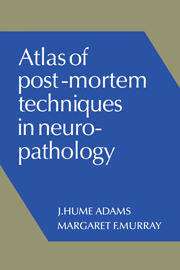2 - The Base of the Skull
Published online by Cambridge University Press: 21 May 2010
Summary
The base of the skull and its main anatomical features are illustrated in Fig. 2.1. The principal structures that may require to be examined are the pituitary gland, the cavernous sinuses, the trigeminal ganglia and the middle ear. The orbital contents are considered separately in chapter 3.
The technique to be adopted depends on the circumstances of each individual case. Thus the pituitary gland is usually simply removed from the pituitary fossa as shown in Figs. 2.2 – 2.6: in a patient with an adenoma of the pituitary gland, however, or some other tumour that affects this region such as a chordoma, a central segment of the base of the skull should be removed so that the extent of the tumour can be assessed, e.g. to what extent an adenoma of the pituitary gland has invaded into the cavernous sinuses or the adjacent bone. A similar technique should be used in a patient suspected of having thrombosis of a cavernous sinus. The block of bone removed can be decalcified, and sections cut in the sagittal, horizontal or coronal plane depending on the type of lesion that is being investigated.
Using an electric saw with a fan–shaped blade, cuts should be made along the lines indicated in Fig. 2.1: this central block of bone can then be levered away from the base of the skull after cutting through the soft tissue in the nasopharynx.
- Type
- Chapter
- Information
- Atlas of Post-Mortem Techniques in Neuropathology , pp. 34 - 43Publisher: Cambridge University PressPrint publication year: 1982

